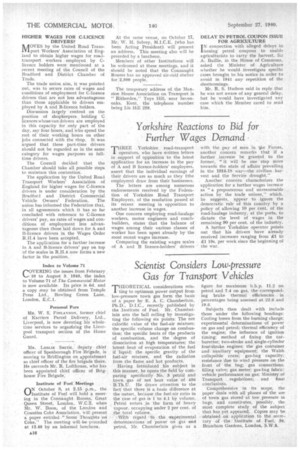Scientist Considers Low-pressure
Page 18

If you've noticed an error in this article please click here to report it so we can fix it.
Gas for Transport Vehicles
THEORETICAL considerations rola thig to optimum power output from low-pressure town gas form the basis of a paper by E. A. C. Chamberlain, Ph.D., D.I.C., recently published by the .Institute of Fuel. Mr. Chamberlain sets the ball rolling by investigating the following six points: The net calorific value of the fuel-air mixture; the specific volume change on combustion; the specific heats of the products of combustion, and the 'degree of dissociation at high temperatures; the latent heat of evaporation of the fuel if liquid; the specific gravity of the fuel-air mixture, and the radiation from the flame and hot products.
Having introduced his subject in this manner, he opens the field by comparing specifically No. 3 petrol and town, gas of net heat value of 456 B.Th.U. He draws attention to the fact that there is a .basic difference at the outset, because the fuel-air ratio in the case of gas is I to 4.1 by volume. . Petrol enters in the form of heavy vapour, occupying under 2 per cent. of ,the total volume..
With regard :to. the •Uxperimental determinations of power on gas and petrol, Mr. Chamberlain gives as a
figure for maximum blep. 11.2 on petrol and 7.4 on gas, the corresponding brake thermal efficiencies in percentages being assessed at 22.6 and 19.6.
Subjects then dealt with include those under the following headings: Cooling losses from the burning charge; experimental determinations of power on gas and petrol; thermal efficiency of the engine; the influence of ignition timing; method of fixing. the carburetter; two-stroke and single-cylinder four-stroke engines; the gas container and auxiliary equipment; the Walsh collapsible crate; gas-bag capacity; resistance due to wind pressure on the front of the bag; gas connections; filling valve; gas meter; gas-bag fabric: vehicle performance on gas; Ministry of Transport regulations; and final con cl usione.
. Comprehensive in its scope, the paper deals with' all phases of the use of town gas stored at low pressure in bags, and constitutes, possibly, the most complete study of the subject that has yet appeared. Copies may be Obtained .011 application to the soca', tars' of the Institute of Fuel,, 30, Bramham Gardens, London, S.NAT.5.




















































